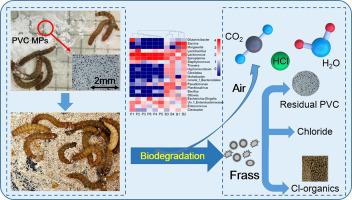Environment International ( IF 11.8 ) Pub Date : 2020-09-15 , DOI: 10.1016/j.envint.2020.106106 Bo-Yu Peng 1 , Zhibin Chen 1 , Jiabin Chen 1 , Huarong Yu 2 , Xuefei Zhou 1 , Craig S Criddle 2 , Wei-Min Wu 2 , Yalei Zhang 1

|
Tenebrio molitor larvae (Coleoptera: Tenebrionidae) are capable of depolymerizing and biodegrading polystyrene and polyethylene. We tested for biodegradation of Polyvinyl Chloride (PVC) in T. molitor larvae using rigid PVC microplastic powders (MPs) (70–150 μm) with weight-, number-, and size-average molecular weights (Mw, Mn and Mz) of 143,800, 82,200 and 244,900 Da, respectively, as sole diet at 25 °C. The ingestion rate was 36.62 ± 6.79 mg MPs 100 larvae-1 d-1 during a 16-day period. The egested frass contained about 34.6% of residual PVC polymer, and chlorinated organic carbons. Gel permeation chromatography (GPC) analysis indicated a decrease in the Mw, Mn and Mz by 33.4%, 32.8%, and 36.4%, respectively, demonstrating broad depolymerization. Biodegradation and oxidation of the PVC MPs was supported by the formation of O C and O
C and O C functional groups using frontier transform infrared spectroscopy (FTIR) and 1H nuclear magnetic resonance (1H NMR), and by significant changes in the thermal characteristics using thermo-gravimetric analysis (TGA). Chloride released was counted as about 2.9% of the PVC ingested, indicating limited mineralization of the PVC MPs. T. molitor larvae survived with PVC as sole diet at up to 80% over 5 weeks but did not complete their life cycle with a low survival rate of 39% in three months. With PVC plus co-diet wheat bran (1:5, w/w), they completed growth and pupation as same as bran only in 91 days. Suppression of gut microbes with the antibiotic gentamicin severely inhibited PVC depolymerization, indicating that the PVC depolymerization/biodegradation was gut microbe-dependent. Significant population shifts and clustering in the gut microbiome and unique OTUs were observed after PVC MPs consumption. The results indicated that T. molitor larvae are capable of performing broad depolymerization/biodegradation but limited mineralization of PVC MPs.
C functional groups using frontier transform infrared spectroscopy (FTIR) and 1H nuclear magnetic resonance (1H NMR), and by significant changes in the thermal characteristics using thermo-gravimetric analysis (TGA). Chloride released was counted as about 2.9% of the PVC ingested, indicating limited mineralization of the PVC MPs. T. molitor larvae survived with PVC as sole diet at up to 80% over 5 weeks but did not complete their life cycle with a low survival rate of 39% in three months. With PVC plus co-diet wheat bran (1:5, w/w), they completed growth and pupation as same as bran only in 91 days. Suppression of gut microbes with the antibiotic gentamicin severely inhibited PVC depolymerization, indicating that the PVC depolymerization/biodegradation was gut microbe-dependent. Significant population shifts and clustering in the gut microbiome and unique OTUs were observed after PVC MPs consumption. The results indicated that T. molitor larvae are capable of performing broad depolymerization/biodegradation but limited mineralization of PVC MPs.
中文翻译:

黄粉虫(Coleoptera:Tenebrionidae)幼虫中聚氯乙烯(PVC)的生物降解。
黄粉虫幼虫(鞘翅目:Tenebrionidae)能够解聚聚苯乙烯和聚乙烯并对其进行生物降解。我们在测试聚氯乙烯(PVC)的生物降解黄粉虫幼虫使用的硬质PVC塑料微粉末(MPS)(70-150μm),以重量,号-和大小均分子量(M瓦特,男Ñ和M z)分别为143,800、82,200和244,900 Da,作为25°C下的唯一饮食。16天期间的摄入率为36.62±6.79 mg MPs 100幼虫-1 d -1。背叛的弗拉斯含有约34.6%的残留PVC聚合物和氯化有机碳。凝胶渗透色谱法(GPC)分析表明M w降低,M n和M z分别为33.4%,32.8%和36.4%,表明广泛的解聚。通过使用前沿变换红外光谱(FTIR)和1 H核磁共振(1 H NMR)形成O  C和O
C和O  C官能团,以及通过使用热能显着改变热特性,可以支持PVC MP的生物降解和氧化。重量分析(TGA)。释放的氯化物被计算为摄入的PVC的约2.9%,这表明PVC MP的矿化有限。T. molitor幼虫仅以聚氯乙烯为食,在5周内存活率高达80%,但在3个月内没有完成其生命周期,存活率仅为39%。使用PVC加共同饮食的麦麸(1:5,w / w),他们仅在91天内就完成了与麸皮相同的生长和化脓。用抗生素庆大霉素抑制肠道微生物会严重抑制PVC的解聚,这表明PVC的解聚/生物降解与肠道微生物有关。食用PVC MPs后,观察到肠道微生物组和独特的OTUs发生了显着的种群迁移和聚集。结果表明,T。molitor幼虫能够进行广泛的解聚/生物降解,但PVC MPs的矿化作用有限。
C官能团,以及通过使用热能显着改变热特性,可以支持PVC MP的生物降解和氧化。重量分析(TGA)。释放的氯化物被计算为摄入的PVC的约2.9%,这表明PVC MP的矿化有限。T. molitor幼虫仅以聚氯乙烯为食,在5周内存活率高达80%,但在3个月内没有完成其生命周期,存活率仅为39%。使用PVC加共同饮食的麦麸(1:5,w / w),他们仅在91天内就完成了与麸皮相同的生长和化脓。用抗生素庆大霉素抑制肠道微生物会严重抑制PVC的解聚,这表明PVC的解聚/生物降解与肠道微生物有关。食用PVC MPs后,观察到肠道微生物组和独特的OTUs发生了显着的种群迁移和聚集。结果表明,T。molitor幼虫能够进行广泛的解聚/生物降解,但PVC MPs的矿化作用有限。



























 京公网安备 11010802027423号
京公网安备 11010802027423号